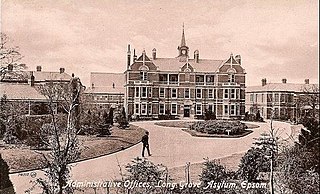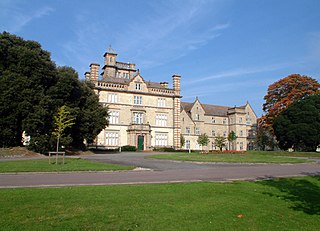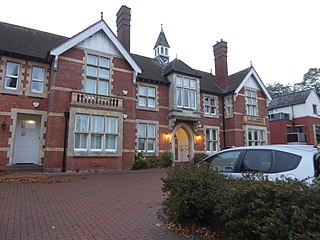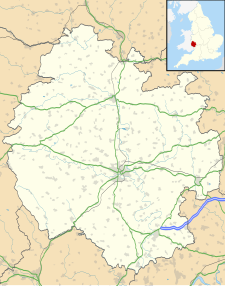
Taunton State Hospital is a psychiatric hospital located on Hodges Avenue in Taunton, Massachusetts. Established in 1854, it was originally known as the State Lunatic Hospital at Taunton. It was the second state asylum in Massachusetts. Most of the original part of the facility was built in a unique and rare neo-classical style designed by architects Boyden & Ball. It is also a Kirkbride Plan hospital and is located on a large 154-acre (62 ha) farm along the Mill River.

Long Grove Hospital, formerly Long Grove Asylum, was a mental hospital, part of the Epsom Cluster of hospitals in the Horton area of Epsom, Surrey in the United Kingdom.

The Countess of Chester Hospital is the main NHS hospital for the English city of Chester and the surrounding area. It currently has 625 beds, general medical departments and a 24-hour accident and emergency unit. It is managed by the Countess of Chester Hospital NHS Foundation Trust, one of the first Foundation Trusts in the UK, formed in 2004. Cardiac rehabilitation services at the hospital are provided by Cheshire and Wirral Partnership NHS Foundation Trust.

Fulbourn Hospital is a mental health facility located between the Cambridgeshire village of Fulbourn and the Cambridge city boundary at Cherry Hinton, about 5 miles (8 km) south-east of the city centre. It is managed by the Cambridgeshire and Peterborough NHS Foundation Trust. The Ida Darwin Hospital site is situated behind Fulbourn Hospital. It is run and managed by the same trust, with both hospitals sharing the same facilities and staff pool.

Woolmanhill Hospital was a health facility in the city centre of Aberdeen, Scotland. It was the original Aberdeen Royal Infirmary, a complex which opened in 1749 and was replaced by new facility at Foresterhill in 1936. After services transferred to Aberdeen Community Health and Care Village, the Foresterhill site and Woodend Hospital, the Woolmanhill Hospital closed in April 2017. The complex is centred on a neo-classical main block with later nineteenth century buildings to the rear. Unusually, it has remained largely complete, with later building having taken place at Foresterhill. It was managed by NHS Grampian.

The University Hospital Geelong, formerly the Geelong Hospital, is an Australian public hospital located in Ryrie Street, Geelong, Victoria. The hospital is part of Barwon Health, Victoria's largest regional health care provider, which has 21 sites. It is the largest hospital in regional Victoria and the only tertiary hospital outside of the Melbourne Metropolitan area. The site is bounded by Ryrie, Bellarine, Myers, and Swanston Streets.

Leicester General Hospital (LGH) is a National Health Service hospital located in the suburb of Evington, about three miles east of Leicester City Centre, and is a part of University Hospitals of Leicester NHS Trust. It has approximately 430 beds. The hospital is the largest employer in the area.

West Park Hospital was a large psychiatric hospital in Epsom, Surrey.
The Woolhope Naturalists' Field Club is a society devoted to the natural history, geology, archaeology, and history of Herefordshire, England. Founded in 1851, it has had many notable members and played an important early role in the history of mycology in Britain.

The Hereford Museum and Art Gallery is a museum and art gallery located in the cathedral city of Hereford, Herefordshire, England.

St. Mary's Hospital was a psychiatric facility located in the village of Burghill, Herefordshire.

Middlewood Hospital is a former psychiatric hospital situated between the suburbs of Middlewood and Wadsley in the City of Sheffield, South Yorkshire, England. It was also known as the South Yorkshire Asylum (1872–1888), the West Riding Asylum, Wadsley (1889–1929) and Wadsley Mental Hospital (1930–1948). It was one of four hospitals that made up The West Riding General Asylums Committee. It closed in 1996 and is now a private housing development called Wadsley Park Village.
St James' Hospital was a healthcare facility in Balham, London that existed between 1910 and 1988. The hospital buildings occupied sites within the boundary of Ouseley Road, Sarsfield Road and St James's Drive Balham London SW12.

Hereford County Hospital is an acute general hospital on Stonebow Road in Hereford. It is managed by Wye Valley NHS Trust.

Littlemore Hospital was a mental health facility on Sandford Road in Littlemore, Oxfordshire.

The Royal Dundee Liff Hospital, previously known as Dundee Lunatic Asylum and Dundee Royal Lunatic Asylum, was a mental health facility originally established in 1812 in Dundee, Scotland. It was originally located in premises in Albert Street Dundee, but later moved out of the town to new buildings in the nearby parish of Liff and Benvie. Buildings at Liff included Greystanes House, which was the main building, and, Gowrie House, which was the private patients' facility. Both Grade B listed buildings.

The Royal Albert Edward Infirmary, also known as the Wigan Infirmary, is a health facility in Wigan Lane, Wigan, Greater Manchester, England. It is managed by the Wrightington, Wigan and Leigh NHS Foundation Trust.

The Victoria Eye Hospital was a health facility located on Eign Street in Hereford, England. The main building has since been converted into apartments.
Henry Graves Bull was a British medical doctor, botanist, mycologist, naturalist, historian, and one of the early presidents of the Woolhope Naturalists' Field Club. He is noteworthy as a mycologist, pomologist, and the co-editor with Robert Hogg of the 2-volume work The Herefordshire Pomona, published in 7 parts from 1876 to 1885. The 2 volumes contain full descriptions of 423 varieties of apples and pears.

















